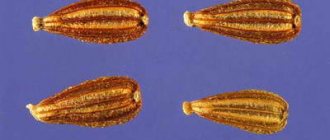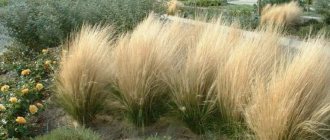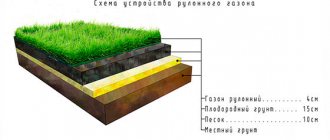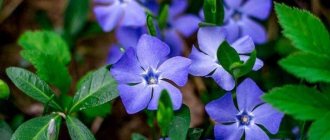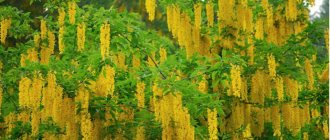Feather grass (Stipa) is a perennial of the genus of monocotyledonous herbaceous plants from the Poaceae family. Over 300 species are known. These are mainly steppe and semi-desert plants. Therefore, feather grass is often called steppe grass. Some plant species are subject to protection and are listed in the Red Book of Russia (feather grass is beautiful, pubescent-leaved). Other names for cereals:
- feather grass;
- hairs;
- sheep death;
- kipets;
- silk grass;
- Maryin flax;
- ponytail;
- stepchina;
- pernik;
- whistle
Botanical description
Feather grass is a herbaceous perennial plant 30-100 cm high. It grows in groups, in dense turf. The rhizome is not creeping, short.
The stems are erect, thin, glabrous, and shortly drooping under the nodes.
The leaves are very thin, hard, rolled lengthwise or flat, pointed at the top. The width of the leaves is about 0.3-0.5 cm.
The inflorescence is a panicle. It consists of 5-20 spikelets, reaching a length of 3-5 cm. Inside the spikelets, during the flowering period, behind two scales before flowering there is a flower. Blooms from May to July.
The plant reproduces by seeds, which are hidden in the flower scales. The seeds are pointed, oblong up to 1 cm. At the tip they have a spine or hair up to 40 cm in length. The spine is geniculate and bent in the middle. The lower part is bare, the upper part is feathery with hairs about 0.5 cm. Thanks to this part, the seeds are carried over long distances. There is another way of reproduction. From rain or dew, the stems of feather grass become heavier and bend to the ground. The center of gravity is located at the bottom of the grain, so its lower part digs and screws like a screw into the soil, burrowing deeper and deeper. Gradually, the cereal dries out, and the spikelet breaks off from the stem and, together with the seeds, remains on the surface of the earth. Over time, a new plant forms in this place.
Spreading
The sharp point at the base of the long awn contains the actual grass seed. The wind helps disperse the seeds. Another way feather grass can spread seeds is when the soil gets wet and then dries out. The earth expands and contracts, causing the tip to twist and unwind, driving the seed into the ground.
Feather grass is a valuable food for both wild animals and livestock because the plant begins to grow in early spring, when other grasses are still dormant.
Habitat
Feather grass grows in many countries. These are mainly temperate latitudes (Western Europe, from the Middle Urals to Transbaikalia, central Russia). But in the southern regions it can also be found in the steppe and forest-steppe zones, in semi-deserts (Northern African countries, the Gobi Desert, Caspian regions). Selects open hills, rocks, dry meadows, rocky places under rocks. The type of feather grass depends on the region of growth. The plant is very popular in landscape design and is widely used in flower arrangements and borders.
Chemical composition and beneficial properties
Very little is known about the chemical composition of feather grass, since this herb is practically not used at all in traditional medicine. Official sources only talk about the presence of fiber (up to 35%), fat (up to 2.7%), and protein (up to 10.8%). It is also known that feather grass is rich in cyanogenic compounds, in particular trigloquinine. Large doses of this substance are poisonous due to the presence of large amounts of hydrocyanic acid. These biologically active compounds allow the plant to be used as a medicinal raw material in folk medicine. Subject to the rules for procurement and storage of raw materials, medicinal products based on feather grass have the following effects:
- calming;
- painkillers;
- anti-inflammatory;
- improve blood circulation.
All parts of the cereal crop are used to prepare medicines. Based on them, products are prepared that are used for:
- prostate adenoma;
- paralysis;
- paresis after stroke;
- rheumatism;
- radiculitis;
- multiple sclerosis;
- diseases of the thyroid gland, including goiter.
Contraindications
People prone to allergies should be careful when handling feather grass changes. They can cause an attack of suffocation and asthma. Even a harmless bouquet of dried flowers, which contains this cereal plant, can be a source of exacerbation of the disease. It is recommended that pregnant and lactating women avoid using products based on this cereal. When preparing medicines based on horse tail, it is necessary to strictly observe the proportions to avoid poisoning, which manifests itself in the form of nausea, dizziness, abdominal cramps and a feeling of weakness. Before treatment, you should consult a doctor.
Traditional medicine recipes
The main thing in the preparation of medicines based on feather grass is compliance with the proportions and use strictly in accordance with the dosage of the resulting drug.
- Tincture for tumor-like enlargement of the thyroid gland (goiter). Add 1 tbsp to a glass of boiled milk. l. dry crushed feather grass. Boil for about 5 minutes and leave for 30 minutes. Take a few sips (2-3) before meals 3 times a day. You can also make lotions from this decoction on the area where the thyroid gland is located.
- Prostate adenoma. If you are ill, you can prepare a sitz bath with herbs: feather grass (preferably feathery) and horsetail. Mix the plants in a 1:1 ratio. Pour three handfuls of the resulting mixture into 2 liters of boiled water. Leave for about 50-60 minutes and filter. Take a bath before bed, wrapping yourself in a blanket or warm blanket. It is advisable to do an enema before the procedure.
- Paralysis. For a glass of milk brought to a boil, take 1 tbsp. l. raw materials. Boil for 15 minutes and let sit for an hour. Take in small sips before meals 3 times a day. For paralysis, you can also use a herbal mixture that includes feather grass and Echinops. In this case, the Echinops will enhance the effects of the feather grass. Chopped dried herbs, take 1 tbsp. (1:1), add to a thermos and pour a glass of boiling water over them. Leave for 12 hours. Strain the finished infusion and drink throughout the day.
- Radiculitis and multiple sclerosis. Use 1 tsp. mixtures of feather grass and Echinops seeds. Place in a dark container and add 100 ml of alcohol. Leave in a dark place for 3 weeks. Strain and take 1 tsp orally. 2 times a day 60-90 minutes after meals. For severe radiculitis, rub into affected areas.
- Rheumatism and joint pain. In this case, you can use separately harvested seeds. 1 tsp crushed seeds pour 100 ml of alcohol. Leave in a dark place for 7 days. Take orally an hour after meals 2 times a day (1 tsp). If you feel pain, you can lubricate the affected areas with the product. Another remedy for these ailments is a decoction of milk or water. Boil the dry raw material until it swells and leave to brew for about 20-30 minutes. When warm, apply to the sore spot for 30 minutes, wrap with a cloth to maintain heat.
Growing the finest feather grass from seeds
Planting and caring for the finest feather grass, the photo of which is presented below, does not present any particular difficulties even for novice gardeners. This plant is sown directly in open ground - this can be done both in spring, in April-May, and in autumn. In the second case, the first shoots of feather grass appear much faster, they are stronger and more stable than those in spring.
An area on the sunny side is best suited for planting feather grass. The steppe plant is very sensitive to excess moisture and is highly resistant to drought, therefore it “prefers” dry soils, without the threat of flooding by groundwater. Add lime to acidic soil first.
Step-by-step planting of feather grass:
- dig up the area and make holes about 2-3 cm deep;
- the distance between the holes should be at least 20-30 cm;
- water the prepared hole;
- Place 4-5 seeds in the hole, sprinkle lightly, but do not compact too much.
Among all the varieties of steppe feather grass, the thinnest one is considered the most “capricious”. It is sensitive to weather changes with poor germination and rapid death of sprouts, so open planting can be replaced by preliminary cultivation of seedlings.
Growing feather grass seedlings
Feather grass is distinguished by its unpretentiousness to the soil. When growing this plant through seedlings, you can use both store-bought substrate and ordinary soil from the garden plot.
Rules for growing seedlings:
- water the soil in flower pots;
- place 3 feather grass seeds in each container;
- lightly sprinkle the seeds in a thin layer of about 1 cm, without pressing - this will prevent the seed from being damaged;
- spray the crops with a spray bottle.
The optimal time for growing seedlings is March. The first shoots appear very quickly - after 5-7 days. After just a month, the seedlings can be planted.
When the seedlings have grown enough, they are transplanted into open soil in the garden. It is best to do this in May.
Signs associated with feather grass
Since ancient times, feather grass has been considered a widow's grass. If a woman brought it home, it meant that she would soon become a widow. This was connected with the attack of nomads on villages and cities, killing all males. These raids coincided with the flowering of feather grass. It was believed that the spikelets of this cereal resembled the gray hair of widows.
There is also a good sign associated with this plant. Several centuries ago, people considered feather grass to be an unusual plant that could protect against trouble. It was believed that this grass belonged to the spirits of the steppe. And they kept a small bunch of feather grass under their clothes as a talisman.
Interesting Facts
Feathergrass can produce about 1091-1455 kg of feed per acre of land. This grass is also good as hay for livestock in the fall and winter. American Indians used it as a hair comb. The seeds were burned and the tough stems were tied together to form a brush.
It is used for ornamental purposes and is available for sale in nurseries.
The plant is sold in nurseries under the names "elegant spear grass", "pony tail" and "angel hair".
Common types
Despite the huge number of varieties of this cereal plant, the most common ones are actually very few. Frequently encountered:
- Pinnate. Found in meadows and steppes of Kazakhstan and Siberia. It got its name for its soft flowers that look like bird feathers. Listed in the Red Book of Russia. Can be grown in garden plots as an ornamental plant.
- Hairy (Tyrsa). Grows in the mountain meadows of Western Europe, Central Asia and the steppes of Mongolia. The plant is medium tall with long fluffy awns that resemble hair. It is also an endangered species listed in the Red Book of the Russian Federation. The ear has a silver-green tint.
- The most beautiful. Tall cereal with a reddish awn. The ear is finely drooping, smooth. Included in the Red Book of Russia, the Republic of Belarus and Ukraine.
- The thinnest. A very heat-loving cereal. This is explained by the presence of Mexican roots. Grows up to 80 cm in length. It has white-silver panicle inflorescences and very thin, hard leaves.
- Fluffy cloud. A distinctive feature is the small height (up to 50 cm) of the spikelets, which merge into one lush mass.
- Zalessky. It belongs to the feathery species and is distinguished by a three-toothed tongue resembling a panicle. The leaves are hairy with small protuberances. Tolerates intense heat and dry weather. It grows on the slopes of the middle regions of the Russian Federation and the western regions of China.
INTERESTING: Feather grass is a very thorny plant and is not considered a forage plant. The shepherds call it sheep's death. If its seeds get on the skin of an animal, then inflammatory and purulent processes begin in these places. It's called Featherfeather Disease. If the problem is not corrected in time, the livestock may die.
Basic rules of care
When growing feather grass, the finest of seeds, gardeners do not have any difficulties caring for this steppe plant. The main emphasis is on active control and prevention of the appearance of weeds, which really “love” the proximity to feather grass.
When caring for the plant, you need to consider how the feather grass tolerates drought. This grass is a steppe plant that grows in semi-desert regions, so it can easily tolerate hot, dry weather. Excess moisture for the finest feather grass causes much more harm than its deficiency.
In the first year after planting in open ground, the plant needs to be watered regularly - this promotes its rapid rooting. After this, the plant does not need abundant watering. The only exception is long-term hot, dry weather, as a result of which the feather grass can dry out, turn yellow and lose its decorative appeal.
The finest feather grass does not require the application of organic or mineral fertilizers. They have a too “strong” composition, which can have an aggressive effect on the thin stems and inflorescences of the plant.
To mulch the soil, thin sawdust is used, which is poured in a thin layer after preliminary loosening the soil. Before the onset of the first frost, all faded spikelets must be removed, leaving the leaves.
Reproduction and transplantation of feather grass
The finest feather grass is propagated by dividing the bush. This is the simplest, fastest and most effective way to decorate your garden plot with new, green stems.
To do this, carefully divide the rhizome of the plant into 3-4 fragments, and then transplant it into separate holes. The optimal time for feather grass propagation is mid or late August.
One of the features of feather grass is the absence of the need for regular transplants. The plant has a short and thin rhizome and does not tolerate transplants very well, which can injure it. Plants grown from seeds are considered the most fragile and sensitive. That is why steppe grass is replanted every 10-15 years.
Diseases and pests
The finest feather grass is characterized by extremely strong immunity and resistance to various diseases and pests. Even if all the plants in the flowerbed are affected by fungal diseases, the feather grass remains completely healthy. Infection of a steppe plant is possible only in the case of extensive damage to all garden crops by infectious diseases and pests.
In rare cases, the finest feather grass can be affected by mites or aphids. In such cases, pest insects can be treated with a concentrated soap solution or washed off with strong water pressure.
